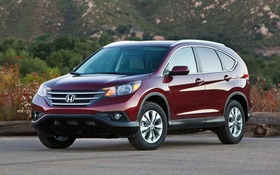2013 Honda CR-V: Our hero!

| Strong points |
|
|---|---|
| Weak points |
|
The Honda CR-V has been gracing Canadian roads since 1996. It was one of the first compact SUVs offered on the market and it still enjoys an excellent reputation today. The CR-V reached its peak in 2012, when it sold more than 33,000 units in Canada, making it one of the most popular vehicles in its category. This spike in sales was mostly due to the release of the model’s outstanding fourth generation. So for 2013, there are no major changes to report, as the CR-V continues to ride the wave of the latest generation’s success.
More inspired style
Honda has been criticised in recent years for producing vehicles that are all about engineering and reliability, but have no soul. The latest CR-V marks a return to inspired design, featuring a fully revamped exterior that has done away with the square angles seen in the past. The result is a more fluid and modern design that balances style and convenience effortlessly. If you look carefully, you’ll notice that the window design makes it look like the roofline plunges steeply toward the back – in keeping with the latest trends – but in actual fact the roof is relatively flat, meaning that rear passengers can enjoy a good amount of headroom and there is plenty of vertical space in the cargo hold. This is a major advantage over its Korean competitors, the Hyundai Tucson and Kia Sportage.
Other notable features that make up its visual signature include the classic Honda front grille and the CR-V’s distinctive tail lights mounted high on either side of the liftgate. On a less pleasant note, the handle for the hatch is too low, so it gets dirty fast and is easily obstructed by snow in winter. It’s also too bad that none of the trims offers a hands-free power liftgate.
More cargo space than any other
On board, the CR-V is demure yet attractive. All trims come with a back-up camera and heated seats, features that other manufacturers don’t usually include in their basic equipment. The instrumentation is clear and easy to read, and most dashboard controls are easy to reach and understand. The overall effect is cleaner than in the past – a definite improvement. Rear passengers are treated to excellent visibility, far superior than in the Kia Sportage and Hyundai Tucson. The CR-V’s squarish roof and lower beltline in the back are to thank for this. Passengers, especially children, will appreciate the view.
The large hatch makes it easier to load the vehicle. And speaking of which, the CR-V is the hands-down champ of cargo space! With 1,054 litres of space (2,007 litres with the bench folded down), it beats all its competitors. We were able to pack my two kids’ hockey equipment, as well as my coaching stuff. Major points scored with our family!
AWD: Can’t live without it!
There aren’t too many choices to be made under the hood, as all trims come with the same 2.4L four-cylinder engine that produces 185 horsepower and 163 lbs.-ft. of torque. This is the same engine that we saw in the previous generation, but it has been tweaked to be slightly more powerful and decidedly more fuel efficient. The CR-V has also been equipped with an ECON system. When activated, it adjusts the vehicle and engine’s different parameters to reduce fuel consumption.
This engine is adequate enough and proves more vigorous than many of the four-cylinder engines offered by the competition. That said, some competitors do better with their optional engines. As for the transmission, it’s a five-speed automatic on all trims. You have to wonder why they didn’t offer a six-speed gearbox to save even more fuel.
The only mechanical decision you have to make is whether or not you want all-wheel drive. Oftentimes, buyers are tempted to go for front-wheel drive because it costs less. In the CR-V, the difference is a little more than $2,000. We like to think that all-wheel drive is not really necessary and we can live without it – yeah, until you find yourself in the middle of a snowstorm! The truth is, nothing beats AWD when it comes to traction on slippery roads. The principle is simple: power is transmitted to four surfaces as opposed to two.
Our hero
Oh, the simple pleasure of starting up at a green light without sliding left or right, of being at the wheel of a stable vehicle, and of plowing through snow drifts without getting stuck! Yes, these are the conditions that we faced during our test drive, which happened to coincide with a record-braking dump of snow in Montreal. Our CR-V even came to the rescue during this historic event. Several vehicles had become stuck, for more than an hour, on a ramp leading up to the highway. We discussed a strategy with other drivers and concluded that we would use the CR-V to clear a path around the various stranded vehicles. The result ended up being the perfect publicity for the CR-V. And the all-wheel drive proved it was worth every penny!
During the test period, we recorded an average fuel consumption of 10.1L/100 km. Obviously, this is well above the manufacturer’s advertised figures, but we couldn’t really expect better given the winter conditions.
From day one, the CR-V has always been a major player in its category and this new generation has just strengthened its position. It certainly won our hearts during our three-week test drive.











